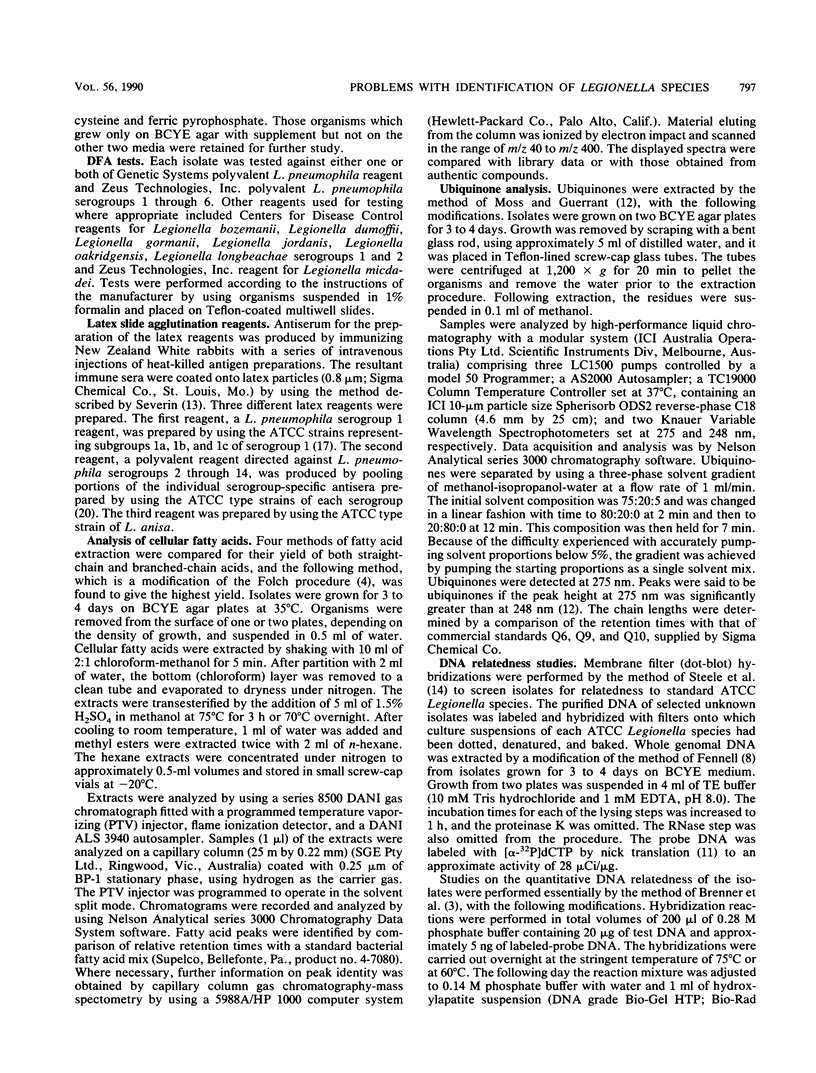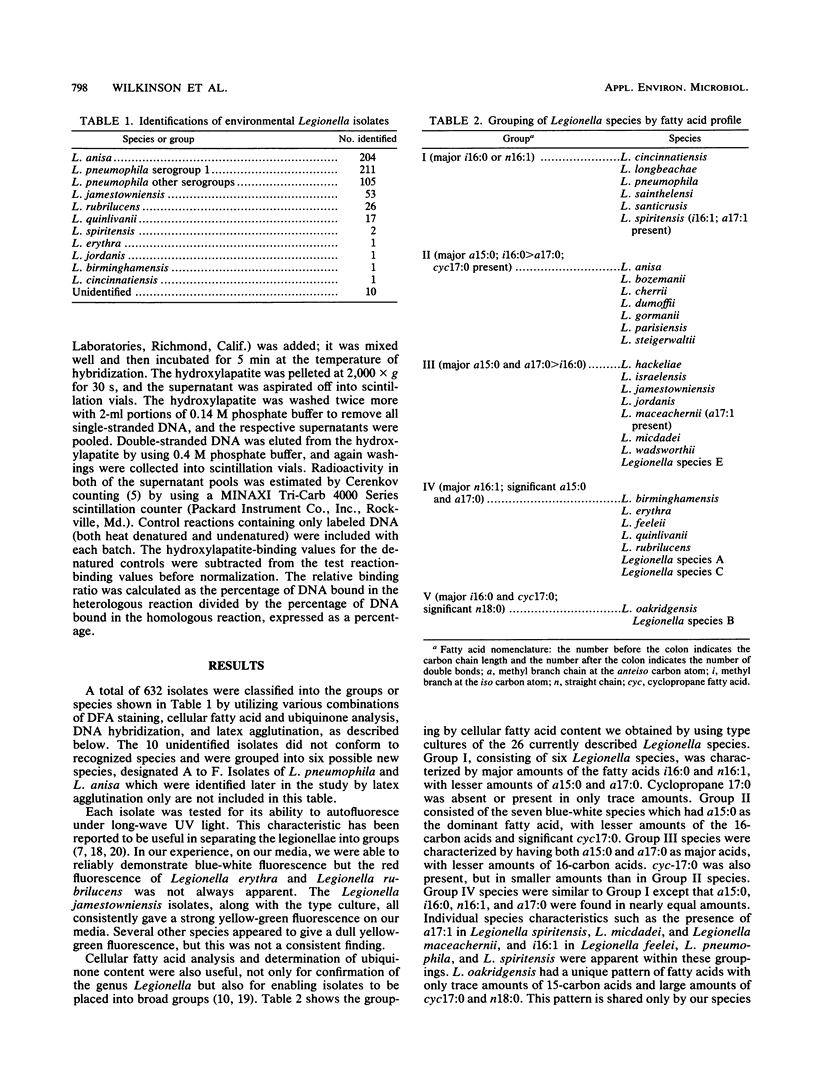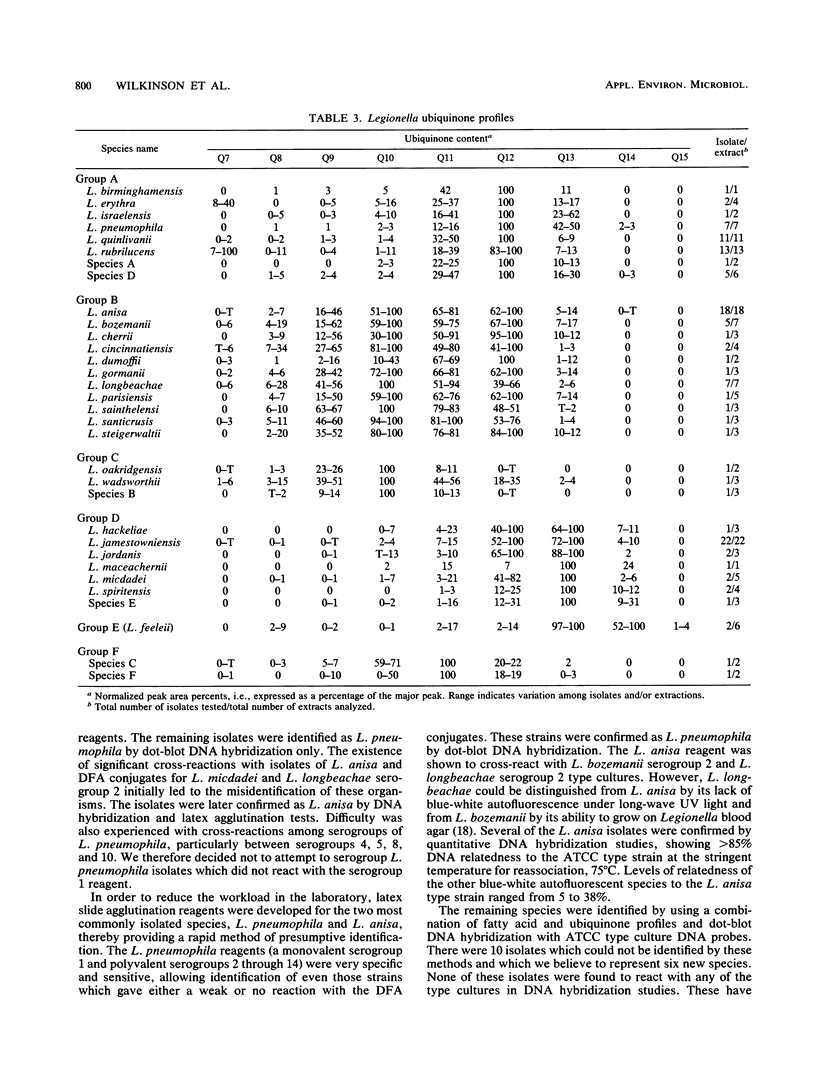Abstract
Following investigation of an outbreak of legionellosis in South Australia, numerous Legionella-like organisms were isolated from water samples. Because of the limited number of commercially available direct fluorescent-antibody reagents and the cross-reactions found with some reagents, non-pneumophila legionellae proved to be difficult to identify and these isolates were stored at -70 degrees C for later study. Latex agglutination reagents for Legionella pneumophila and Legionella anisa developed by the Institute of Medical and Veterinary Science, Adelaide, Australia, were found to be useful as rapid screening aids. Autofluorescence was useful for placing isolates into broad groups. Cellular fatty acid analysis, ubiquinone analysis, and DNA hybridization techniques were necessary to provide definitive identification. The species which were isolated most frequently were L. pneumophila, followed by L. anisa, Legionella jamestowniensis, Legionella quinlivanii, Legionella rubrilucens, Legionella spiritensis, and a single isolate each of Legionella erythra, Legionella jordanis, Legionella birminghamensis, and Legionella cincinnatiensis. In addition, 10 isolates were found by DNA hybridization studies to be unrelated to any of the 26 currently known species, representing what we believe to be 6 possible new species.
Full text
PDF






Selected References
These references are in PubMed. This may not be the complete list of references from this article.
- Bopp C. A., Sumner J. W., Morris G. K., Wells J. G. Isolation of Legionella spp. from environmental water samples by low-pH treatment and use of a selective medium. J Clin Microbiol. 1981 Apr;13(4):714–719. doi: 10.1128/jcm.13.4.714-719.1981. [DOI] [PMC free article] [PubMed] [Google Scholar]
- Brenner D. J., Fanning G. R., Rake A. V., Johnson K. E. Batch procedure for thermal elution of DNA from hydroxyapatite. Anal Biochem. 1969 Apr 4;28(1):447–459. doi: 10.1016/0003-2697(69)90199-7. [DOI] [PubMed] [Google Scholar]
- Clausen T. Measurement of 32P activity in a liquid scintillation counter without the use of scintillator. Anal Biochem. 1968 Jan;22(1):70–73. doi: 10.1016/0003-2697(68)90260-1. [DOI] [PubMed] [Google Scholar]
- Fennell C. L., Totten P. A., Quinn T. C., Patton D. L., Holmes K. K., Stamm W. E. Characterization of Campylobacter-like organisms isolated from homosexual men. J Infect Dis. 1984 Jan;149(1):58–66. doi: 10.1093/infdis/149.1.58. [DOI] [PubMed] [Google Scholar]
- Lambert M. A., Moss C. W. Cellular fatty acid compositions and isoprenoid quinone contents of 23 Legionella species. J Clin Microbiol. 1989 Mar;27(3):465–473. doi: 10.1128/jcm.27.3.465-473.1989. [DOI] [PMC free article] [PubMed] [Google Scholar]
- Moss C. W., Guerrant G. O. Separation of bacterial ubiquinones by reverse-phase high-pressure liquid chromatography. J Clin Microbiol. 1983 Jul;18(1):15–17. doi: 10.1128/jcm.18.1.15-17.1983. [DOI] [PMC free article] [PubMed] [Google Scholar]
- Severin W. P. Latex agglutination in the diagnosis of meningococcal meningitis. J Clin Pathol. 1972 Dec;25(12):1079–1082. doi: 10.1136/jcp.25.12.1079. [DOI] [PMC free article] [PubMed] [Google Scholar]
- Steele T. W., Sangster N., Lanser J. A. DNA relatedness and biochemical features of Campylobacter spp. isolated in central and South Australia. J Clin Microbiol. 1985 Jul;22(1):71–74. doi: 10.1128/jcm.22.1.71-74.1985. [DOI] [PMC free article] [PubMed] [Google Scholar]
- Thacker W. L., Benson R. F., Staneck J. L., Vincent S. R., Mayberry W. R., Brenner D. J., Wilkinson H. W. Legionella cincinnatiensis sp. nov. isolated from a patient with pneumonia. J Clin Microbiol. 1988 Mar;26(3):418–420. doi: 10.1128/jcm.26.3.418-420.1988. [DOI] [PMC free article] [PubMed] [Google Scholar]
- Thacker W. L., Plikaytis B. B., Wilkinson H. W. Identification of 22 Legionella species and 33 serogroups with the slide agglutination test. J Clin Microbiol. 1985 May;21(5):779–782. doi: 10.1128/jcm.21.5.779-782.1985. [DOI] [PMC free article] [PubMed] [Google Scholar]
- Thomason B. M., Bibb W. F. Use of absorbed antisera for demonstration of antigenic variation among strains of Legionella pneumophila serogroup 1. J Clin Microbiol. 1984 Jun;19(6):794–797. doi: 10.1128/jcm.19.6.794-797.1984. [DOI] [PMC free article] [PubMed] [Google Scholar]
- Vesey G., Dennis P. J., Lee J. V., West A. A. Further development of simple tests to differentiate the legionellas. J Appl Bacteriol. 1988 Oct;65(4):339–345. doi: 10.1111/j.1365-2672.1988.tb01900.x. [DOI] [PubMed] [Google Scholar]


